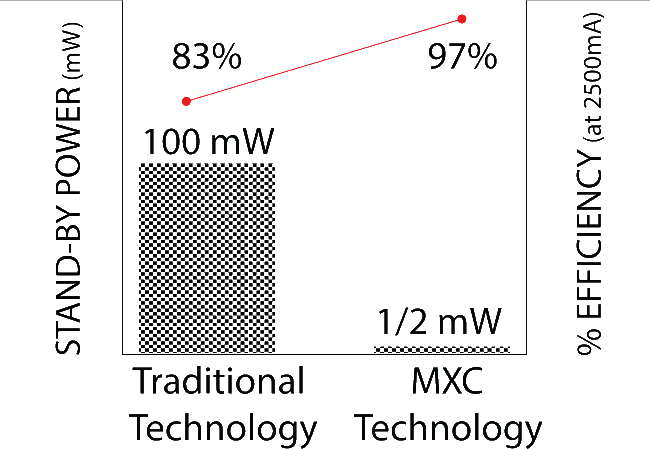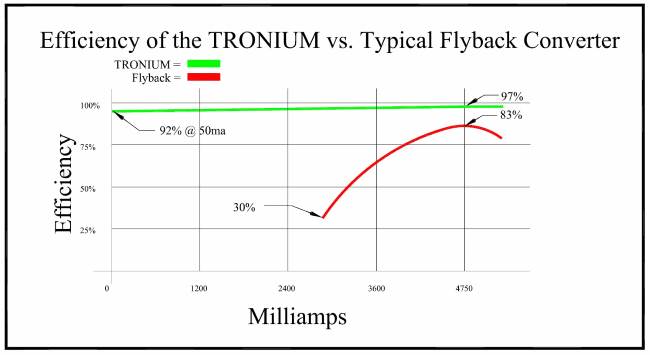BY MICHAEL FREEMAN, CEO,
Semitrex,
www.semitrex.com
The Internet of Things (IoT) is gaining momentum. However, before the estimated 90 billion new IoT devices are attached together, greater standby efficiencies are needed. Currently, there are about 14 billion electronic devices connected through a network to datacenters. The IEA estimates that number will grow to 50 billion by 2020, as more residential appliances such as refrigerators, microwaves, washer/dryers, and dishwashers become network-connected as well. All of these devices draw power even when not in use – this is known as a “vampire load” – energy use from electronic devices plugged into the wall but not in use (also known as stand-by power). A recent Forbes article stated that the world wastes 400 terawatt-hours (TWh) of energy per year due to vampire loading. Many companies are trying to solve this world-wide problem.
One solution, Muxcapacitor (MXC) technology, reduces vampire loads by increasing stand-by mode efficiency. The upcoming 2016 Department of Energy Level VI regulations will require stand-by power on smaller than 49-W devices to be no more than 100 mW. Through using multiple cascaded capacitor banks, MXC technology is able to shut down enough banks when a device is inactive to achieve a stand-by power of ½ mW – which is 200 times more efficient than the DOE standard (see Fig. 1 ).

Fig. 1: The MXC technology reduces vampire loads to achieve a stand-by power 200x more efficient than the DOE standard.
In addition to government regulations of stand-by power, there is a demand from governments and consumers alike for electronic devices that are more energy efficient when in use. Consumers want to reduce their monthly energy bills, while governments and utility companies want to limit the demand on the grid to reduce the potential for brown-outs or rolling blackouts. This potential will increase with the additional burden of IoT devices.
Traditional transformer-based power conversion has been around since the 1800s, but due to the 45 to 50 or so discrete parts that are typically used in connection with traditional transformer designs, the industry has only made incremental improvements to efficiency. These transformer voltage reduction power supply systems rely on inductors, which use magnetic fields for voltage reductions from the mains. However, magnetic fields lose electrons as they build and collapse – causing the transformer-powered device to become hot to the touch due to the wasted (lost) energy. The design improvements made to metal oxide semiconductor field-effect transistors (MOSFETs) have required the technology to become increasingly dense over the years, which has increased heat generation. Often, these systems now require a heat sink or other cooling apparatus to ensure that there is no damage to the electronic device. Other efficiency efforts to reduce core losses and increase the energy efficiency of transformers include a larger core made from more expensive materials. This increases the up-front cost of the equipment, and a trade-off is made for the increased efficiency.
Capacitive voltage reduction is the first breakthrough power supply technology since the transformer. This technology traps the electrons within capacitors via transistor gates, then releases the electrons only when the gates are open. This reduces the loss of electrons as heat, and therefore increases efficiency. Previously, capacitors were mainly relegated for use in line conditioning applications to reduce power dips and improve power quality. Semitrex has repurposed the capacitor technology to handle the primary voltage conversion in its patented, modularized TRONIUM Power Supply System on a Chip. MXC technology uses capacitive voltage reduction methods that have small energy conversion ratios. This is far more energy efficient than standard transformer technology, which uses large conversion ratios. The “mux” in Muxcapacitor refers to the many channels of energy coming from the bank of small capacitors embedded into the silicon chip. Each capacitor is responsible for a small conversion ratio, which means it is able to transfer almost all of the electrons without energy loss. The capacitors only sustain a small portion of the input voltage and therefore only support a small portion of the output current. This allows for high efficiency – even at small loads. Inductors, in contrast, have to sustain the full voltage and current and therefore see less efficiency. Capacitors also benefit from a much higher energy density than inductors.
The MXC efficiency gains are due to a series of cascading capacitors controlled through interconnected transistor gates. At 50-mA of current in a 5-V system, MXC technology is 92% efficient and goes up to 97% efficiency at 1 A and above (see Fig. 2 ). This is in contrast to a typical flyback converter, which can’t handle that small a current and maxes out at 83% efficiency. As stated above, MXC technology is able to achieve ½ mW of stand-by power. The series of small capacitors allows the system to shut down most of the capacitor banks, so only a few are active to “sense” the next charge or on/off event.

Fig. 2: The modularized TRONIUM Power Supply System on a Chip uses capacitive voltage reduction methods and provides up to 97% efficiency at 1 A.
MXC has better stand-by power load, increased efficiency and does not get hot to the touch. In fact, the entire TRONIUM Power Supply System seeks to reduce the energy footprint and cuts the number of different components in half (from an average of 50) with its modular approach. MXC technology is mostly embedded in the chip, along with the algorithms, switches and gate technologies necessary for power conversion and regulation. The modular power supply system further helps to reduce the energy footprint by streamlining the manufacturing process and eliminating many fabrication steps.
Any electronic device requiring stand-by power can become more energy efficient using MXC technology. Applications for this technology are many and varied – from chargers for cell phones and laptops to residential household appliances, industrial electronics, medical devices, telecom and hand held devices, and data centers. The low conversion ratios of MXC technology also make it more useful than inductor technology in FET gates, embedded switches and passive elements. MXC capacitive voltage reduction has the ability to significantly reduce worries about IoT vampire loads, and sets a new bar for power supply efficiencies.
Advertisement





